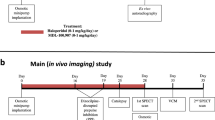Abstract
Central D2-dopamine receptor occupancy was followed by repeated PET experiments after administration of single oral doses of haloperidol to four healthy men. D2-dopamine receptor occupancy was high already 3 h after administration of 4 and 7.5 mg haloperidol and remained high for at least 27 h. Akathisia appeared when D2-dopamine receptor occupancy was maximal. After initiation of neuroleptic drug treatment several days or weeks may elapse before antipsychotic effect is evident. The results of this study do not indicate that any late onset of the antipsychotic effect is related to an insufficient D2-dopamine receptor occupancy during the first days of treatment.
Similar content being viewed by others
References
Barnes TRE (1989) A rating scale for drug-induced akathisia. Br J Psychiatry 154:672–676
Bergström M, Boëthius J, Eriksson L, Greitz T, Ribbe T, Widén L (1981) Head fixation device for reproducible position alignment in transmission CT and positron emission tomography. J Comput Assist Tomogr 5:136–141
Bohm C, Greitz T, Blomquist G, Farde L, Forsgren PO, Kingsley D, Sjögren I, Wiesel F-A, Wik G (1986) Applications of a computerized adjustable brain atlas in positron emission tomography. Acta Radiol Suppl 369:449–452
Braude WM, Barnes TRE, Gore SM (1983) Clinical characteristics of akathisia. Br J Psychiatry 143:139–150
Bunney BS (1984) Antipsychotic drug effects on the electrical activity of dopamine neurons. TINS 7:212–215
Carlsson A, Lindquist M (1963) Effect of chlorpromazine or haloperidol on formation of 3-methoxytyramine and normetanephrine in mouse brain. Acta Pharmacol Toxicol 20:140–144
Creese I, Burt DR, Snyder SH (1976) Dopamine receptor binding predicts clinical and pharmacological potencies of antischizophrenic drugs. Science 192:481–483
Farde L, von Bahr C (1990) Distribution of remoxipride to the human brain and central D2-dopamine receptor binding examined in vivo by PET. Psychiatr Scand 82:67–71
Farde L, Ehrin E, Eriksson L, Greitz T, Hall H, Hedström C-G, Litton J-E, Sedvall G (1985) Substituted benzamides as ligands for visualization of dopamine receptor binding in the human brain by positron emission tomography. Proc Natl Acad Sci USA 82:3863–3867
Farde L, Pauli S, Hall H, Stone-Elander S, Eriksson L, Halldin C, Högberg T, Nilsson L, Sjögren I (1988a) Stereoselective binding for11C-raclopride in living human brain — a search for extrastriatal central D2-dopamine receptors by PET. Psychopharmacology 94:471–478
Farde L, Wiesel F-A, Halldin C, Sedvall G (1988b) Central D2-dopamine receptor occupancy in schizophrenic patients treated with antipsychotic drugs. Arch Gen Psychiatry 45:71–76
Farde L, Wiesel F-A, Nordström A-L, Sedvall G (1989) D1- and D2-dopamine receptor occupancy during treatment with conventional and atypcial neuroleptics. Psychopharmacology 99:S28-S31
Farde L, Wiesel F-A, Stone-Elander S, Halldin C, Nordström A-L, Hall H, Sedvall G (1990) D2-dopamine receptors in neurolepticnaive schizophrenic patients. Arch Gen Psychiatry 47:213–219
Johnstone EC, Crow TJ, Ferrier IN, Frith CD, Owens DGC, Bourne RC, Gamble SJ (1983) Adverse effects of anticholinergic medication on positive schizophrenic symptoms. Psychol Med 13:513–527
Kendler KS (1976) A medical student's experience with akathisia. Am J Psychiatry 133:454–455
Larsson M, Forssman A, Öhman R (1983) A high-performance liquid chromatographic method for the determination of haloperidol and reduced haloperidol in serum. Curr Ther Res 34:999–1008
Litton J, Bergström M, Eriksson L, Bohm C, Blomqvist G, Kesselberg M (1984) Performance study of the PC-384 positron camera system for emission tomography of the brain. J Comput Assist Tomogr 8:74–87
Peroutka SJ, Snyder SH (1980) Relationship of neuroleptic drug effects at brain dopamine, serotonin, α-adrenergic, and histamine receptors to clinical potency. Am J Psychiatry 261:1518–1522
Sassin JF, Frantz AG, Weitzman ED, Kapen S (1972) Human prolactin: 24-hour pattern with increased release during sleep. Science 177:1205–1207
Seeman P, Lee T, Chau-Wong M, Wong K (1976) Antipsychotic drug doses and neuroleptic/dopamine receptors. Nature 261:717–719
Tolis G (1980) Prolactin: physiology and pathology. Hosp Pract 15:85–95
van Rossum JM (1966) The significance of dopamine receptor blockade for the mechanism of action of neuroleptic drugs. Arch Int Pharmacodyn Ther 160:492–494
Wode-Helgoth B, Borg S, Fyrö B, Sedvall G (1978) Clinical effects and drug concentrations in plasma and cerebrospinal fluid in psychotic patients treated with fixed doses of chlorpromazine. Acta Psychiatr Scand 58:149–173
Author information
Authors and Affiliations
Rights and permissions
About this article
Cite this article
Nordström, AL., Farde, L. & Halldin, C. Time course of D2-dopamine receptor occupancy examined by PET after single oral doses of haloperidol. Psychopharmacology 106, 433–438 (1992). https://doi.org/10.1007/BF02244811
Received:
Revised:
Issue Date:
DOI: https://doi.org/10.1007/BF02244811




